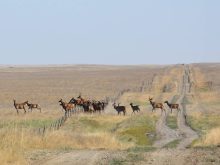SASKATOON – Bumblebees are more effective at pollinating forage crops than honeybees or leafcutter bees, but it may be awhile before farmers are using them to pollinate crops, said an Agriculture Canada scientist.
“There are commercial colonies available. They’re expensive compared to the value of legume crops,” said Ken Richards, from the Lethbridge research station.
Because bumblebee pollination was so successful in greenhouses, scientists hoped to transfer the technology to legume crops. When bumblebees in greenhouses are used to pollinate tomato plants the grade of tomato is improved.
Read Also

Crop quality looks good this year across Prairies
Crop quality looks real good this year, with the exception of durum.
Bumblebees were tested on the legume cicer milkvetch at two locations in southern Alberta. The bees were placed on a 1.5 ha field and a three ha field. The seed yield was “significantly higher” on the 1.5 ha field with the higher stocking rate of bees, Richards told producers during a recent Canadian Alfalfa Seed conference.
In 1993 the seed yield on the 1.5 ha crop was 666 kg/ha, about double the 321 kg/ha yield on the three ha field.
In 1994, the seed yield on the 1.5 ha field was 578 kg/ha, double the 222 kg/ha yield on the three ha field.
Different species of bumblebees were also tested on fields of sainfoin, alfalfa and annual forage legumes.
In southern Alberta there are 22 different kinds of bumblebees, a fraction of the 500 different bumblebees worldwide.
Bumblebees hibernate in the soil. The queens are first out in spring, consuming nectar and searching for a suitable nesting site. Modern farming practices damage native bee populations, Richards said.
“There are just too many flowers produced per area and too few bees for the bees to pollinate a high proportion of them at an economic level.”
















